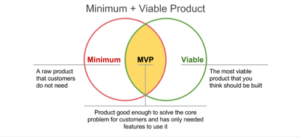
How to ideate and build a roadmap for your MVP
17th May, 2021
Most people like to gamble, and when the gamble pays off, the thrill is absolute. MVP is some sort of gamble, because in a way it is a guessing game, where you release a Minimum Viable product into the market, and keep your fingers crossed that it would work.
The term Minimum Viable product was coined by SyncDev CEO Frank Robinson in 2001, and mentioned in the book, The Lean Startup by Eric Ries. Published in 2011, the book contains a sentence that describes the term perfectly well – “The minimum viable product is that version of a new product which allows a team to collect the maximum amount of validated learning about customers with the least effort, as Ries wrote.
With MVP only the core features of the product will be released into the market to learn how people would respond to it. Every huge product in the market was released small, and with popular acceptance became hugely successful.
From this, it is easy to understand that:
- MVP follows the lean startup philosophy so there is the iterative process of building – business-analyzing-learning loop until it meets market demand.
- MVP is the process in itself, and not the ultimate product.
- The MVP must sell, it must have real value that users can use.
- MVP may not have all the elements, but it must have the core features that attracts early adopters
With the insights from MVP feedback, companies can avoid releasing unnecessary products into the market, and save money in the process. Many of the big companies that reap huge profit today started out as MVPs. For example, Facebook was once called Thefacebook and this only initially was intended to connect students in a certain college or class. The idea existed as Friends Reunited and later, gained traction and the result of this is pretty much self-explanatory.
Airbnb also started out as an MVP, when a couple of students in San Francisco nurtured the idea of renting out their apartment with the view of earning their own rent money. This idea took off immensely well as it cut out the middleman. The rest is history.
Breakdown of the term – MVP
M – Minimum – Just the basic, but important features, only the core ones
V- Viable – The features must fulfil or realize the needs of the customer
P – Product – A product that users will love, suggest changes to improve product
Here is a checklist of the MVP journey that you follow in the business of creating your own MVP:
Identify the need for your product in the market
This is obviously the first step because unless you know whether your product is needed in the market, how would you know if it would be accepted? If there is a gap in the market that customers would want filled, the product would be instantly accepted. Like Airbnb addresses the problems visitors had when they visited a destination. They always have this option of hiring a few rooms during the course of their stay if they do not prefer staying in a hotel. So if you have such a product, identify the long-term goals and product success criteria before going forward.
Chart the user journey
Identify who the users are, and plan how to create a sense of urgency among them. Decide on the end goal and create an action plan on the steps to be taken to realize that goal. Here, the action means what the users would need to do in order to make the product acceptable in the market (or whatever the requirement is, it could be different depending on what the final goal is – which would even be booking an appointment ).
So while in the market, planning the user journey, it would be wise to focus on users that are more likely to make the action. Make use of social forums, where you have access to a plethora of ideas. Identify areas where potential users hang out, and drop a thread to see if they would be open to the idea you are creating.
A pain and gain map
What are the user’s pain points? If the business is able to identify with the same intensity as the user, then it is possible to focus the features based on that. Focus on the more impactful features, and relegate the less impactful for future releases. Identifying the pain points will help in releasing more successful MVPs into the market.
Brainstorming on the different features to build
Focus on those ideas that are top priority to the product, and include them in the roadmap. List them on their order of importance and take it from there. Keep aside less important features, and give more importance to user-requested features. Keep the audience persona in mind so this process would be easier. It would be a good idea to use opportunity statements to decide on the features that the product requires.
Opportunity statements are those that encourage the users to know more about the product by giving them an irresistible offer. And later, create a prioritization matrix to decide on the high impact ones, followed by the medium impact ones to low impact ones.
Things to remember while planning the user journey:
In the roadmap of planning your MVP, you have identified your users, and have identified the market gaps where your product could be accepted, but there are a few things to remember while mapping the user journey:
The user journey is defined into three main parts – identifying the user, actions of the user and story ending
Identifying the user – The user or the target segment who will be using the product. There might be more than one category of users, so identify them all, and make sure they are rightly identified.
The actions of the user – Every user category has numerous stories of their own. The ending of that story could be achieved as the goal of the product. The actions of the user means the actions the users have to take to achieve the story ending.
The story ending – Each user has their own version of story ending, depending on need. The purpose is to achieve the goal.
The success of MVP is directly related to the feedback received
The success of creating the MVP roadmap can be ensured only when the feedback from the users shows positivity’s. The entire future of the product is grounded by user acceptance. Once the user likes or dislikes the features, it would be easier to analyze what they really need. If it solves the problem, then it will definitely be accepted.
Checking whether the viability of the product is really there
If the product has value, then it would definitely be viable. Some startups make the mistake of going overboard with the features, because, in their experience they might get confused with the important and not so important features. Some startups make the mistake of building too quickly in their haste to crash the market, and will later regret releasing an unfinished product. The product should have quality code, design, content and excellent UI. The features should be connected, have meaning, so avoid random features.
Is MVP a good idea for your business?
The main goal of the MVP is to get user feedback and to check the feasibility of the product in the market. Startups would most certainly benefit from the MVP because they can test the waters before entering the market, and they would know what features to include and what not. If there is a user problem that the product will solve, then by all means go ahead. The MVP idea itself was born from the Lean Startup movement, meaning the business can develop their products in small iterative steps to avoid risks and a move down the wrong path. Once the barebones version of the product is released in the market, just scale it from there. To make your MVP hugely successful, it is important to have a good development team executing the idea. One of the most popular method to validate MVPs in the market currently is Landing Page MVPs. It is quite simple to create, as it would be a single web page that talks about the product, its features and benefits. The activities of the users while visiting this page would serve as data and statistics when analyzing the success of the product. There is another version of Landing Page MVP that’s equally popular – Explanatory Video MVP where instead of textual information about the product, there should be a demo video explaining the product, and how it can address their pain points.
Conclusion
Once you have the roadmap all charted out, it would be easy to release a successful MVP. And with user feedback, it would be easy to identify what features the product lacks, and the features that can be improved upon in the next version. This makes it easy to improve the product in subsequent versions.




